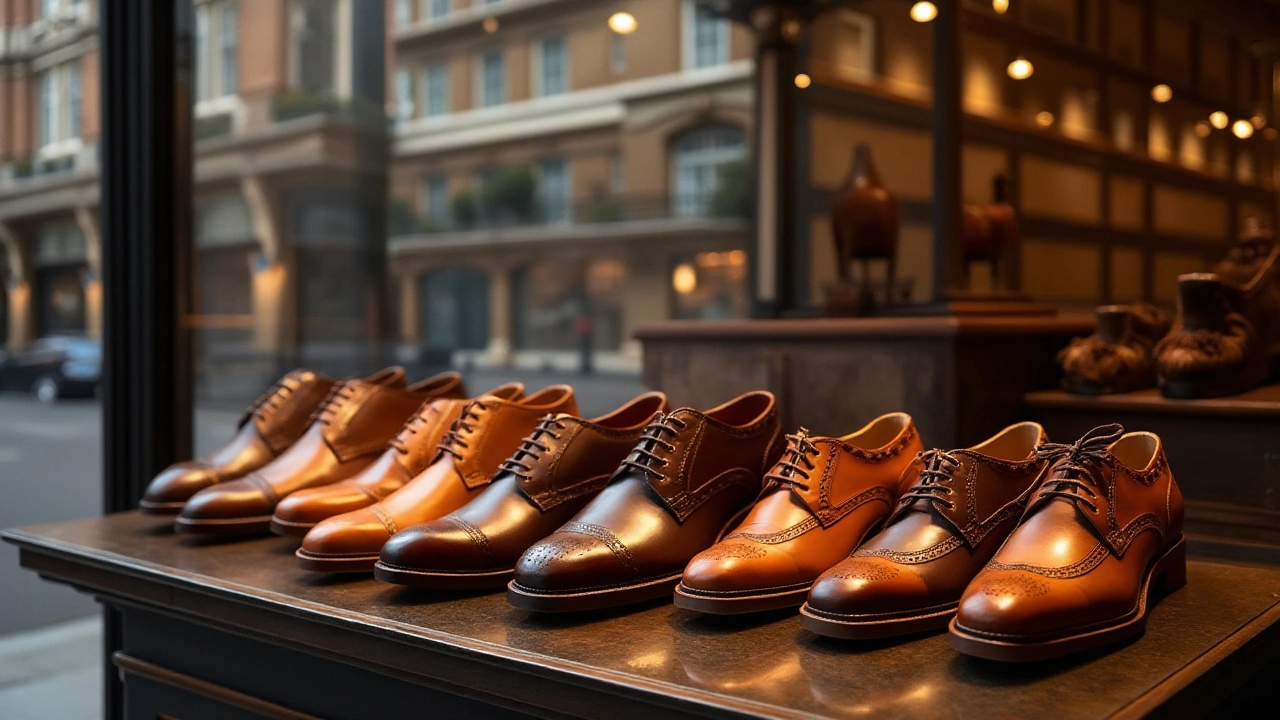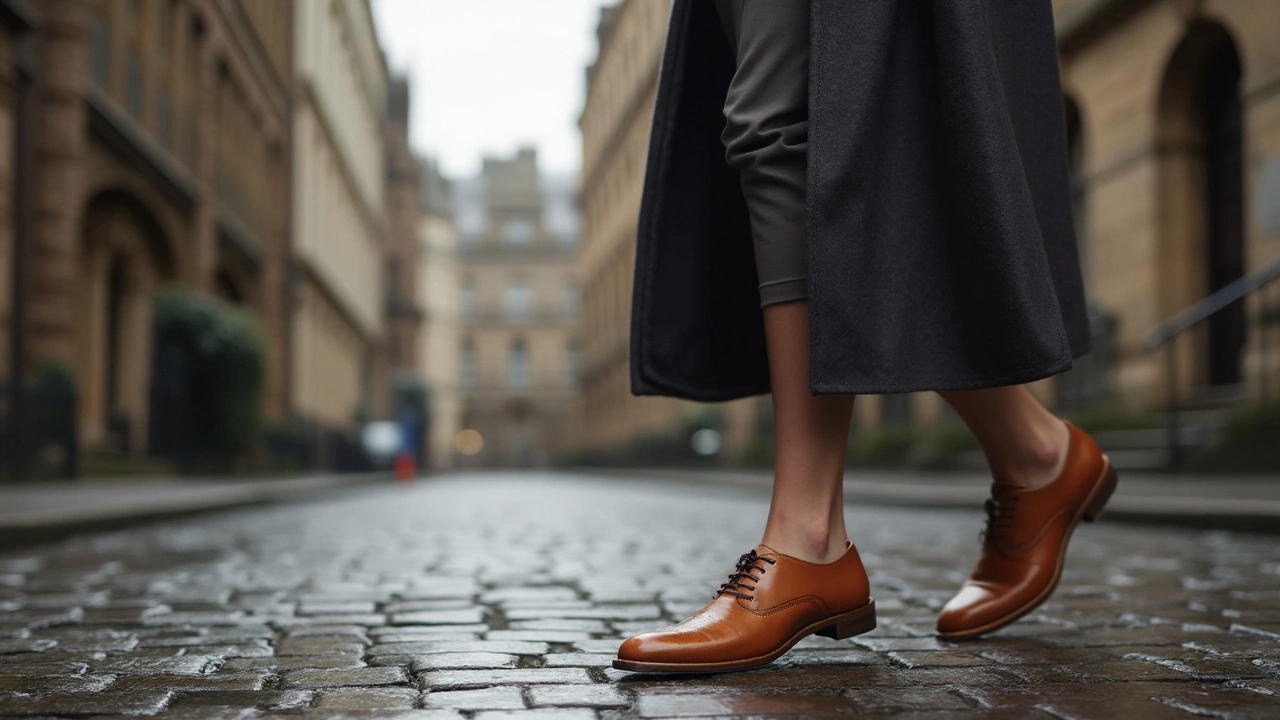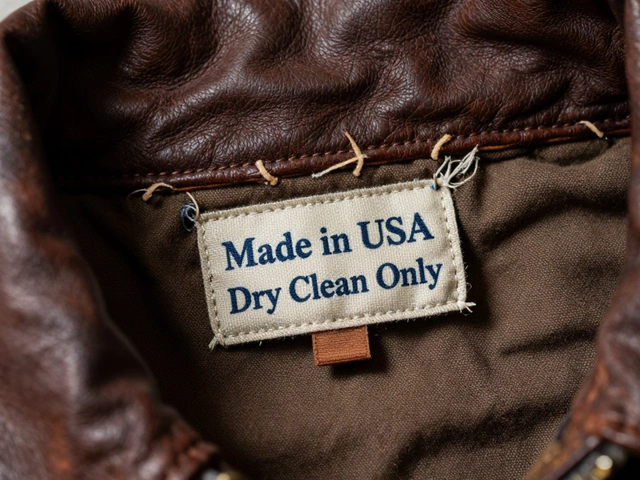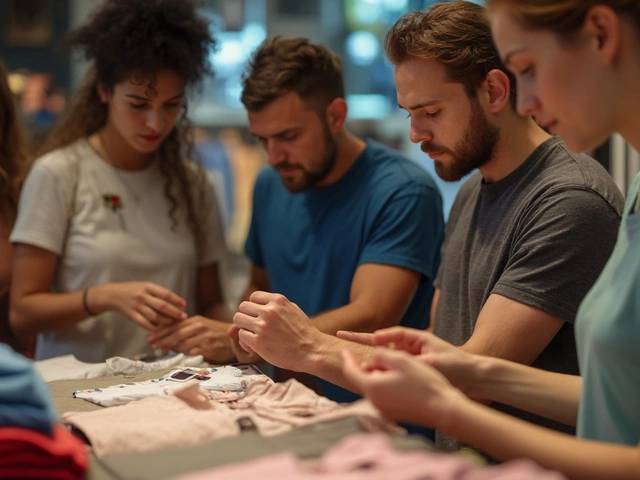Decoding the Symbols and Stories Behind Leather Shoes

- Cleo Fairchild
- 23 December 2024
- 0 Comments
In the vast landscape of fashion, leather shoes have carved out a niche that is imbued with history, mystery, and a certain kind of magic. Far beyond their functional use, these shoes have walked paths of tradition, leaving impressions of status and personal tales. The symbolism sewn into their very structure speaks volumes, transcending mere design.
From the cobblestone streets of ancient cities to the glossy runways of modern fashion weeks, leather shoes have carried more than just feet; they've borne messages and meanings that resonate with our cultural unconscious. Whether preserving the legacy of craftsmanship or marking milestones in personal journeys, these shoes are more than just an accessory. They're a testament to where we've been and where we're heading.
- The Historical Significance of Leather Shoes
- Symbolism and Cultural Impact
- Leather Shoe Iconography and Its Meaning
- Tips for Maintaining Leather Footwear
- Modern Perceptions of Leather Shoes
- Mythology and Rituals Involving Leather Shoes
The Historical Significance of Leather Shoes
Leather shoes have traversed centuries, leaving a legacy that speaks eloquently of human ingenuity and adaptation. Their origins can be traced back to around 3500 BCE, with the discovery of Ötzi the Iceman, whose remarkably preserved body in the Alps was found with leather boots that revealed the craft's early beginnings. These ancient shoes were not merely for protection; they were finely crafted with inner linings and outer soles, showing an early appreciation for comfort and durability in footwear. As societies evolved, so too did the complexity and design of leather shoes, turning them into symbols of social status and cultural identity.
In ancient Egypt, leather sandals symbolized craftsmanship and luxury, often seen in art and archaeological findings adorning the feet of the elite and deities. Similarly, during the Roman Empire, footwear served as a class indicator, where specific styles and colors were restricted to certain societal tiers. The symbolism of footwear as a status marker persisted through the Middle Ages, where elaborate poulaines and leather riding boots underscored the power dynamics among medieval nobility. These historical trends reflect not just aesthetics but also the socio-political context, demonstrating how leather shoes have walked hand in hand with cultural shifts.
The intricate craftsmanship involved in creating leather shoes also holds historical significance. In medieval Europe, cobblers were artists in their own right, and guilds controlled shoe-making practices, ensuring quality and uniformity across the industry. This tradition of skilled craftsmanship is evident in historical artifacts and has significantly influenced the modern perceptions of leather shoes. As much as leather shoes protected feet, they served as a canvas for artistic expression, with each pair telling a unique story about the era and its people.
The Renaissance period marked a revolution in fashion, including footwear. Leather shoes became a critical part of the ensemble, woven into the intricate tapestries of court life. Nobles across Europe invested in opulent designs, and leather footwear became part of the language of fashion, reflecting the wealth and culture of individuals and nations. The continued evolution during this time was not only about practicality but also about cultural pride and identity, often influencing and being influenced by trade, exploration, and exchange across continents.
The industrial revolution brought a seismic shift in the production of leather shoes, moving from bespoke artisanal hands to efficient machines that could produce multiples. This transformation made shoes more accessible, preserving quality while deconstructing the exclusivity that had defined them for centuries. Yet, the soul of leather crafting lived on, championed by luxury brands that cherished tradition while embracing innovation. Both as footwear symbols and functional necessities, leather shoes continued to narrate the unfolding story of human society.
"Fashion is part of the daily air and it changes all the time, with all the events. You can even see the approaching of a revolution in clothes. You can see and feel everything in clothes." — Diana Vreeland
Whether part of ancient rituals, as demonstrated by the use of leather in cultural ceremonies, or as modern expressions of personal style and professional necessity, leather shoes are deeply woven into the fabric of our history. Their enduring presence speaks volumes about the evolution of human needs and desires, from simple protection to elaborate expression. As a historical artifact and a contemporary staple, leather shoes remain a vital piece of our shared cultural heritage.
Symbolism and Cultural Impact
Leather shoes have transcended their utilitarian roots to embody profound cultural significance and symbolism across various societies. Historically, these shoes have been symbols of affluence and authority. In medieval Europe, the quality and style of a person's leather footwear often signified their social standing and wealth. A well-crafted pair of leather shoes was a status symbol, as access to fine leather and the skilled artisanship required to create them were reserved for the elite. The path leather shoes have taken through history is fascinating, reflecting shifts in societal norms and values.
Beyond their economic symbolism, leather shoes carry cultural stories that vary from one part of the world to another. In many cultures, shoes are symbols of journeys and transitions, marking significant changes in a person's life. For instance, in Jewish culture, removing one's shoes can symbolize mourning or humility. Similarly, Native American moccasins often revealed one's heritage and identity, meticulously crafted to convey deeply personal and tribal stories. Leather, as a material, ties these narratives together, acting as a canvas for cultural expression and identity preservation.
The design and style of leather shoes can also carry heavy symbolic weight. In contemporary fashion, leather shoes continue to be associated with professionalism and sophistication. A pair of polished leather shoes can convey diligence and attention to detail, characteristics highly valued in professional settings. They often symbolize reliability and readiness, serving as essential complements to any formal attire. This enduring association entrenches leather shoes in the fabric of our daily expressions of identity.
Interestingly, in art and literature, leather shoes often represent a journey or quest. Think of the iconic ruby slippers in "The Wizard of Oz"—even though not leather, they embody the concept of footwear as a transformative agent, echoing themes of growth, self-discovery, and destiny. In this realm, shoes speak; they narrate the tales of wanderers, dreams, and destinations yet to be achieved, making them compelling motifs in storytelling. As Gabrielle "Coco" Chanel once mused, "A woman with good shoes is never ugly." This sentiment underscores the transformative power that a well-chosen pair of shoes holds.
The significance of leather shoes is further enriched by their appearance in numerous rituals and customs across the globe. In certain Eastern traditions, shoes are ceremoniously exchanged as part of wedding rituals, symbolizing unity and the beginning of a shared journey. Shoes left at thresholds in many cultures stand not only as a sign of respect but also as a vessel collecting the spiritual footprints of guests. Each pair of leather shoes, hence, becomes a repository of both tangible and intangible journeys, ensconcing layers of meaning beyond the visible and tactile reality.
Leather Shoe Iconography and Its Meaning
The iconography embedded in leather shoes carries more than just aesthetic beauty; it unfolds layers of cultural depth and historical narrative. Historically, leather shoes have signified wealth and power. In ancient Egypt, leather sandals were often worn by the elite, crafted meticulously to display vibrancy and artistic flair while serving practical needs. Similarly, in medieval Europe, detailed leatherwork on shoes was seen as a sign of nobility and high social standing. The craftsmanship was as much about utility as it was about broadcasting an individual's stature in society.
In the contemporary landscape, leather shoe designs reflect a mix of traditional influences and innovative trends. The classic brogue, with its distinctive perforations, originated in the early 20th century as outdoor walking shoes in Scotland and Ireland. Today, it symbolizes sophistication and refinement. The imagery on leather shoes can also be seen in cultural motifs intricately etched or embossed into the material. These motifs can range from floral patterns to geometric designs, each carrying specific meanings or stories connected to their origin.
Iconography on footwear extends beyond just symbols; it's about the emotional and cultural connotations these symbols evoke. A pair of Chelsea boots, for instance, has become synonymous with rock and roll rebellion, a symbolism rooted in 1960s Britain when they graced the feet of Beatles and Rolling Stones alike. The appeal and meaning of leather shoes are thus often shaped by who wears them and the stories these individuals create while in motion. The unique morphing of fashion with personal narrative makes leather shoe iconography a fascinating study.
The Symbolism Behind Color and Pattern
Color and pattern also play a vital role in the iconography of leather footwear. Black leather has always been associated with authority and power, while brown signifies reliability and warmth. In today's fashion, bold reds or blues featured in shoes are seen as statements of confidence and individuality, capturing the dynamic and adventurous spirit of modern fashionistas. Patterns such as animal prints or tribal designs reflect a connection to nature and ancestral traditions, bridging a gap between ancient and modern worlds.
The rich iconography of leather shoes offers a canvas for personal expression amidst the vast tapestry of history and culture. "Shoes are the finishing touch to any outfit and it is important to complete a look with the perfect pair," says fashion legend Giorgio Armani.This aligns with the notion that while styles evolve, the essence captured in leather shoe designs remains unchanged—a reflection of identity, aspiration, and the unique path each wearer forges. As we lace up our favorite pair, we step into the footsteps of history while making new tracks of our own, a beautiful dance of continuity and innovation.
Tips for Maintaining Leather Footwear
Maintaining your leather shoes is like safeguarding a piece of fashion history—with the right care, these shoes can last a lifetime and even become more charming as they age. It goes beyond simple cleaning; it's about knowing the needs of the leather shoes, much like understanding a good friend. First, always remember that prevention is key. A dependable shoe tree made of cedar is crucial, not only to keep the shoes in shape but also to absorb moisture and odors. Placing your footwear on these shoe trees immediately after wear can prevent wrinkles from forming.
Routine cleaning is another vital step in leather shoe care. Gently brush off dust and dirt with a soft-bristled brush or a specialized shoe dauber. This practice helps keep the leather’s pores unclogged, preserving its natural sheen and allowing it to breathe. Use a suitable leather conditioner regularly to keep the material supple. Leather, being a natural material, needs moisturizing, akin to how we treat our own skin. Conditioning should be done every few months or after exposure to harsh weather conditions.
"Leather shoes, expertly cared for, are an embodiment of timeless elegance," suggests renowned shoemaker John Lobb, known for creating bespoke leather shoes since the 1800s.
When talking about polish, be particular about the color and type. A neutral polish maintains color diversity, whereas a matching one enhances the shoe’s vibrancy. Applying polish in multiple thin layers with round, circular motions will ensure even coverage and a polished finish. Buffing with a soft cloth thereafter gives the final, appealing shine. Also, periodically waterproofing your leather shoes with a dedicated protectant spray can shield them from unexpected weather surprises.
Storing leather footwear correctly is equally crucial. Leather needs to breathe to retain its quality. Avoid storing them in plastic bags or cramped places. Instead, use a breathable cloth bag or a well-ventilated shoe rack. Seasonal storage can benefit from a dust cover that allows air circulation. Protecting leather shoes from direct sunlight and extreme temperatures will guard against both fading and drying out.
| Care Step | Benefit |
|---|---|
| Using Shoe Trees | Prevents wrinkles, absorbs moisture |
| Regular Cleaning | Keeps leather pores clear |
| Conditioning | Maintains suppleness |
| Polishing | Enhances shine, vibrancy |
| Proper Storage | Prevents fading, drying |
Remember, the charm of leather grows over time, imbibing the stories of its journey, but only when well-kept. These tips do not just maintain their appearance but enhance their longevity, allowing them to walk with you through life’s adventures. Above all, each step in caring for your leather shoes is an act of preserving the delicate balance between artistry and practicality, a tribute to craftsmanship that resonates with the shoes' heritage.

Modern Perceptions of Leather Shoes
In today's fashion-savvy world, leather shoes sit elegantly at the crossroads of style and sustainability, embodying a blend of tradition and innovation that few other fashion items can claim. The allure of leather footwear has evolved from mere functionality to a symbol of sophistication, health-consciousness, and ethical fashion practices. With consumers increasingly valuing longevity and craftsmanship, leather shoes stand out for their timeless appeal, often serving as the go-to choice for those who seek quality over quantity. With the fast-paced fashion cycles promoting renewable trends, leather shoes offer a stability and permanence that make them indispensable in any wardrobe. Their multi-faceted roles and how they blend artistry with practicality cater to those who appreciate the finer things in life.
Interestingly, the contemporary leather shoe is not just about aesthetics or function. It's also a silent advocate of mindful living and environmental responsibility. Many brands now emphasize sourcing leather ethically, ensuring minimal environmental impact, and investing in sustainable production processes. This shift reflects a broader societal change where consumers demand transparency and accountability. For instance, some companies have adopted vegetable-tanning techniques, which reduce chemical usage, making leather shoes a preferred choice for eco-conscious consumers. Reports suggest that nearly 60% of environmentally focused consumers are willing to pay a premium for sustainable products, a statistic that encourages brands to innovate in responsible production.
The market for leather shoes has further diversified with the fusion of technology and traditional craftsmanship, leading to innovations like ergonomic designs and weather-resistant treatments. These advancements make footwear symbols not only an emblem of style but also of comfort and practicality, matching the needs of the modern, dynamic lifestyle. Tailored, custom-fit options also have grown considerably. They utilize digital foot scans, ensuring a perfect fit and greater comfort for each unique foot shape. This intersection of technology and personalization speaks directly to modern desires for individuality and bespoke experiences.
Moreover, the universal appeal of leather shoes is reflected in their versatile presence across corporate, casual, and even athletic settings. They seamlessly adapt to the variety of roles they are required to play, such as a professional meeting must-have or a casual stroll necessity. This adaptability is captured perfectly in today's design ethos, which merges traditional silhouettes with contemporary twists, thereby appealing to an audience that prides itself on being unique yet rooted in classicism. As the New York Times fashion editor once noted, "Leather shoes are an intersection of art and utility, a canvas for self-expression as much as a tool of mobility."
The enduring nature of these shoes not only lines their wearers' feet with elegance but also represents an ongoing dialogue about how fashion can marry aesthetic pleasure with ethical responsibility.
Mythology and Rituals Involving Leather Shoes
In the sprawling annals of mythology and cultural traditions, leather shoes have often walked paths that led far beyond mere pragmatism. Throughout history, these humble objects have been imbued with supernatural qualities and were often seen as conduits of divine or mystical power. Among the numerous tribes and civilizations that revered leather shoes, there was the belief that they not only protected the feet but also provided a spiritual armor, safeguarding travelers on both physical and metaphysical journeys. In many societies, passing down a pair of leather shoes was akin to bestowing a piece of the soul, a belief grounded in the notion that the shoes absorbed the essence of the wearer, along with their fortunes and misfortunes.
Ancient Egyptians, for example, believed that the shoes of their rulers granted them authority to navigate the realms of the living and the dead. The symbolic act of placing a shoe on a newborn's cradle in Greek and Roman cultures was thought to ward off evil spirits, suggesting an intrinsic protective property attributed to footwear. A shoe-themed legend that persists in Northern England speaks of how burying a worn-out leather shoe at the entrance of a house would protect it from malevolent spirits. The shoe, a silent but sturdy guardian, served as a talisman of safety for the inhabitants.
Another fascinating ritual involved shoe tossing. Some cultures practice this during weddings, where shoes are thrown at the newlyweds as a token of good luck and fertility. This action, seemingly whimsical, holds deeper roots: leather shoes were believed to carry the blessings and aspirations of the attendees, enveloping the couple in positive energy. Literary sources, like the works of Shakespeare, often used shoes as literary devices symbolizing fate and fortune—“Give him heedful notice, for I hold it fit that, as my friend, his business may receive a Cornishman as lord” (Cymbeline), highlighting their social and symbolic weight.
Today, while many of these rituals have faded into the shadows of modernity, leather shoes remain a potent symbol in folklore and popular culture. They feature prominently in storytelling—from fairy tales like Cinderella, which highlights transformation and destiny through a single shoe, to modern mythologies in cinema and literature, where leather boots are often worn by heroes embarking on epic quests. This storied past and enduring allure make leather shoes more than just a choice of footwear; they are storytellers themselves, weaving through legends and rituals with the richness of unending narratives. It's in these nuances that a leather shoe transcends its form and becomes enshrined in the mythic tapestry of human culture.


